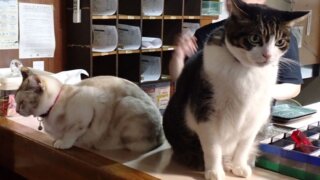Yanai City, Yamaguchi Prefecture, developed during the Edo period as one of the leading commercial port cities in the Seto Inland Sea.
The corner of the city where the merchant house buildings from those days still remain is called the “white-walled cityscape” and has become a popular tourist spot.
The sight of the goldfish lanterns, a folk craft, swimming in front of the eaves of the lanterns makes for an excellent photo!
You’ll also find goldfish-themed goods and gourmet treats all over town.
So, let me take you on a trip to enjoy the goldfish lanterns in Yanai!
Contents
The “white-walled cityscape” is one of the most beautiful in the Seto Inland Sea.
Located in the southeastern part of Yamaguchi Prefecture, Yanai City is about 30 minutes by train from Iwakuni Airport which is in Yamaguchi.
Yanai City has long been a key point of maritime traffic on the Seto Inland Sea, and in the Edo period, the city prospered even more as a commercial city thanks to the ports of call of the Kaisen (cargo and passenger ships of the Edo period).
 Yanai also prospered as a town that waits for the tide, as one of Japan’s three major tidal currents, the Ohatake Seto, is located just to the east.
Yanai also prospered as a town that waits for the tide, as one of Japan’s three major tidal currents, the Ohatake Seto, is located just to the east.In particular, there are many earthen storehouse buildings from the Edo period that still exist in the Furuichi-Kaneya area, which is about a 10-minute walk north of JR Yanai Station.
The beautiful scenery has become one of the most popular sightseeing spots in the city as a “white-walled cityscape“.
This is the main area to enjoy the goldfish lanterns, so let’s stroll around for a while.
 The plastered streetscape shines through. A “goldfish lantern” hangs in front of the eaves.
The plastered streetscape shines through. A “goldfish lantern” hangs in front of the eaves.If you want to take a stroll around Yanai, you should first visit the Yanai City Museum (10:00 a.m. to 5:00 p.m., free admission, closed on Mondays and Thursdays), a Western-style building that stands out from the rest along the street.
In addition to getting a sightseeing brochure, visitors can learn about the town layout of the area through a model exhibit.
 Constructed in 1907 as the head office of the former Suo Bank.
Constructed in 1907 as the head office of the former Suo Bank.
 Inside, models of the surrounding area are displayed.
Inside, models of the surrounding area are displayed.Yanai City Museum
442, Yanaiotsu, Yanai City, Yamaguchi Prefecture
Opening hours 10:00 – 17:00
Closed Mondays and Thursdays, New Year’s
Admission free of charge.
After the tour of the museum, visit the “white-walled cityscape” that stretches for about 200 meters near the museum.
The street is lined with earthen storehouses on both sides, some of which are open to the public, while others have been converted into cafes and restaurants.
 There is also a sign on the street that says “Beware of Crab Crossing“. The river runs behind the street and there are many crabs because it is close to the estuary.
There is also a sign on the street that says “Beware of Crab Crossing“. The river runs behind the street and there are many crabs because it is close to the estuary.There are two breweries of “Kanro soy sauce”, a specialty of Yanai, in the same area, and one of them, “Sagawa Soy Sauce Store”, is open to the public as a museum of Kanro soy sauce (8:00 a.m. to 5:00 p.m., free admission).
You can also sample the water that is pumped up from the basement right in front of the gate, so let’s visit!
 Inside are huge sanjukko-ke (buckets).
Inside are huge sanjukko-ke (buckets).One vat is approximately 5,400 liters, which is the equivalent of 3,000 bottles in a 1.8-mL bottle.
The inside of the warehouse smells faintly of soy sauce!
Kanro soy sauce is made by fermenting the brewed dark soy sauce with koji once more.
It takes about twice as much effort and ingredients as regular soy sauce, but its deep, rich flavor goes well with sashimi and tofu.
You can also buy them at the museum.
Kanro Soy Sauce Museum
3708-1, Yanai Furuichi, Yanai City, Yamaguchi Prefecture
Business hours: 8:00 a.m. to 5:00 p.m. (Sundays and holidays: 9:30 a.m. to 4:30 p.m.)
Irregular holidays.
Admission: free of charge.
0820-22-1830 (Sagawa Shoyu)
Goldfish lanterns decorate the streets
 We can’t help but laugh at the chubby eyes and mouth, and the expression of the pouting.
We can’t help but laugh at the chubby eyes and mouth, and the expression of the pouting.“Yanai’s Folk Artifacts with a Cute “Idiot’s Face.
After strolling around the town, you can enjoy looking at the goldfish lanterns, which are reflected in the nostalgic scenery of old Japan.
Goldfish lanterns were invented by a Yanai merchant who visited Hirosaki City in Aomori Prefecture at the end of the Edo period (1603-1868), inspired by the “goldfish nebuta,” or “goldfish lanterns” that children used to light when they went out for summer festivals.
Aomori Prefecture’s “nebuta matsuri” is famous in Japan.

Afterwards, the improvement was repeated by the craftsman, and after the war, it became the cute style of the “goofy face” of the present round eyes and the mouth of the fidgety mouth.
The festival has become synonymous with the local community as a summer tradition in Yanai.


The basic color is red, but there are various sizes in addition to the color.
The characteristic red color is the result of dyeing from Yanai’s traditional Yanai-Shima fabric, and the basic materials used are bamboo higo and Japanese paper.


Goldfish lanterns are displayed not only in the summer, but throughout the year.


Let’s find out.
Fire hydrant lids I saw at several places while walking around town.
Experience making goldfish lanterns with a souvenir!


You can not only see these goldfish lanterns, but also experience making them.
But, how the goldfish look is up to the creator!
There are two production sites, the Yanai Nishigura and the Kawamura Nobuo Workshop, but this time I visited the Yanai Nishigura, which is located next to the Ganro Soy Sauce Museum.
Goldfish Lantern Crafting at Yanai Nishigura


A lot of goldfish lanterns are displayed at the entrance and inside the building.
There are two types of goldfish lanterns to choose from: large (19cm in girth, 900 yen including tax) and small (14cm in length, 800 yen including tax).
I’m going to try a bigger size this time!


The body is preassembled, and you’ll get to attach the eyes and fins and draw in the scales!
The first step is to draw the patterned lines on the tail and pectoral fins.
I drew slowly, slowly, while watching the model.


Then, apply the eye stickers to the face area.
The position of your eyes determines your expression.
“The best way to make it cute is to put it on the front and sides, around the center of the bamboo belly,” says the staff.
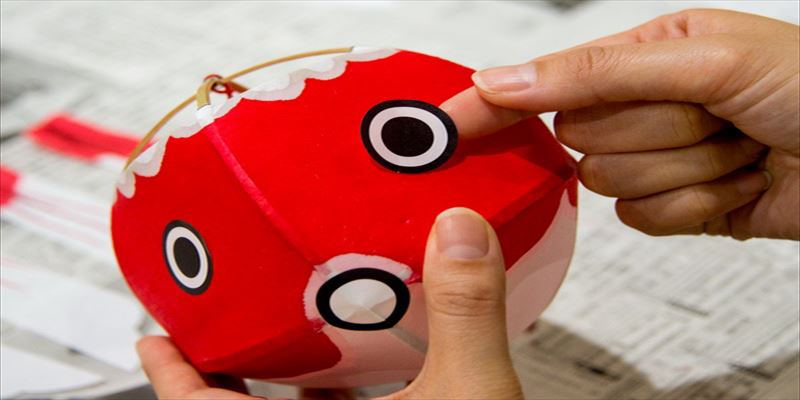

In addition, the dye is applied so that the eyes are framed.
It seems that this is a pretty difficult place, because the white eyes are colored or they cannot be applied evenly.


Now I will draw a pattern of scales on the back of the body.
It’s easy to draw in lines, but some people who are good at drawing express the scales in more detail or draw their own patterns.


Finally, the pectoral and tail fins are glued to the torso.
To avoid any mistakes at the last minute, listen carefully to the staff’s explanations of where to apply it and how much glue to apply.
And after waiting for the glue to dry, it’s done!


I was a little worried at first, but the staff is very helpful and supportive from start to finish.
At the same facility, you can also try your hand at making coasters and dyeing with Yanai-Shima, a traditional craft from Yanai City.
Goldfish Lantern Crafting at Yanai Nishigura
3700-8, Yanai, Yanai City, Yamaguchi Prefecture
Opening hours: 9:00 a.m. to 5:00 p.m. (The trial is open until 4:00 p.m.)
Tuesdays (If the day is a national holiday, the museum is open on Tuesdays and closed the following day.
Admission : free of charge.
Experience making goldfish lanterns
Experience fee: 900 yen for large and 800 yen for small (both tax included)
Access: 10 minutes walk from JR Yanai station
Enjoy the goldfish lantern original goods, stationery, and Japanese and Western goldfish sweets!
After the Goldfish Lantern Crafting, I visited the Kizaka Sho-Bundo Shirakabe store to buy some souvenirs. This is a must-see spot.
Because it’s a stationery store full of goldfish lantern goods!


The store also has a retro atmosphere.
In addition to stationery, you can buy goldfish lanterns at the store.
There are about 200 kinds of goldfish lanterns goods including erasers, pencils, notebooks, congratulatory bags, masking tape and origami, etc.
Moreover, there are many collaboration products with famous manufacturers.
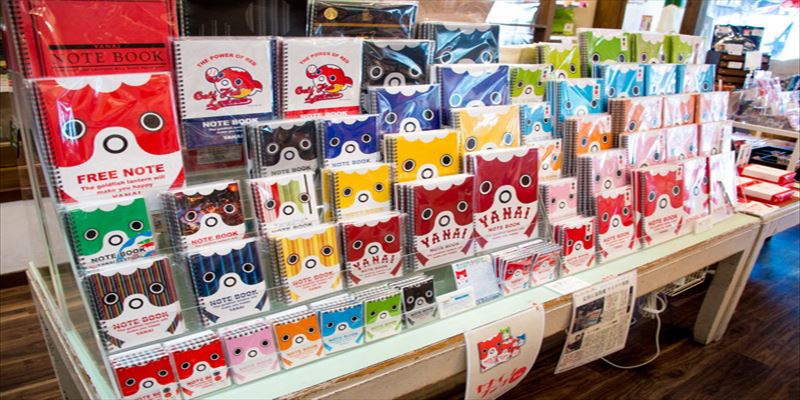

Time seems to pass in the blink of an eye as I pick it up and look at it. Because it’s stationery, the price is reasonable.
Further product development is underway, so you can enjoy new discoveries every time you visit.
Kisaka Sho Bundo, Shirakabe
452 Yanai Tsu, Yanai City, Yamaguchi Prefecture
Business hours:11:00 – 17:00
Closed: Monday
After walking and experiencing the townscape, it was time to get a little hungry.
Now I will take you to a shop where you can enjoy goldfish sweets.
It’s Japanese sweets.
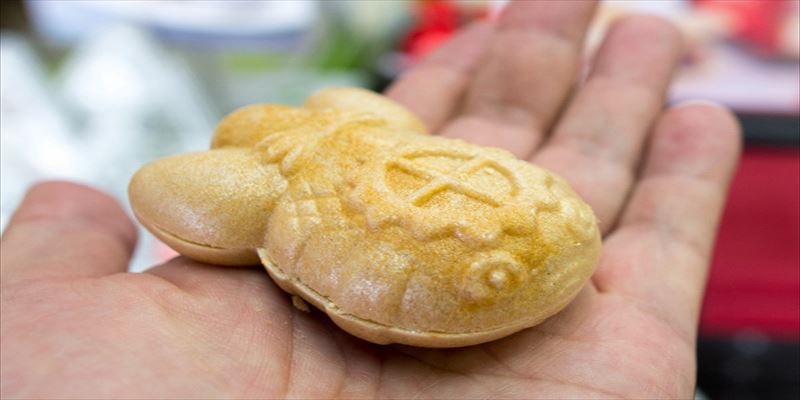

I head to Kijiya, which is about a three-minute walk from Kisaka Sho Bundo.
“Kijiya” is across the street from the Yanai City Museum.
Operated by Asahi Confectionery, a confectionery manufacturer in Yanai familiar to Yamaguchi Prefecture residents.
The highlight of the store is the “Goldfish Monaca,” which is sold only in the summer season, and will appear in mid-June and will be available until the end of August.
“Goldfish Monaca” (125 yen per piece, including tax).
In addition, there is also a dish with rice cakes (125 yen).
I feel kind of sorry for them, but… I’ll take it.
There is a lot of sweet and refreshing bean jam inside.
Kijiya
437 Yanai Tsu Kanaya, Yanai City, Yamaguchi Prefecture
Businesshours: 9:00 – 17:00
Closed: Tuesdays and Wednesdays
4,000 goldfish lanterns will be displayed in the city during the “Goldfish Lantern Festival” In August


If the timing is right for you, I recommend August for a trip to Yanai.
About 4,000 goldfish lanterns are decorated to coincide with the “Goldfish Chochin Festival” held on August 13 every year.
In 2019, from Saturday, August 3 to Sunday, September 1, goldfish lanterns were displayed around the “white-walled townscape.
2,500 of them will actually be lit!



On August 13, the day of the festival, about 10 “goldfish nebuta” will also make an appearance, strolling wildly along the “white-walled streets” that connect the “white-walled streets” with Yanai Station.
In addition to the “Goldfish Lantern Dance,” a variety of other events will be held around the area, including 871 fireworks that will be set off at the finale.


In the “Goldfish Nebuta” event, each group has a different design and expression of a goldfish Nebuta.
Yanai Goldfish Lantern Festival
Venue: JR Yanai Station – Shirokabe Town
Date August 13(every year)
In case of rain, some events will be cancelled.


In the end
How was your trip to Yanai to enjoy the goldfish lanterns?
The “white-walled cityscape” makes you feel as if you’ve slipped back in time to the Edo period, and the contrast between the red of the goldfish and the white of the plaster is beautiful!
More than anything, the more you look at the goldfish lantern’s “somehow tupid face“, the more charming it is.
It’s strange because it’s somehow soothing.
The more you experience making something, the more attached you become to it.
Why don’t you make your own goldfish lanterns in Yanai and let them swim in the space of your home?









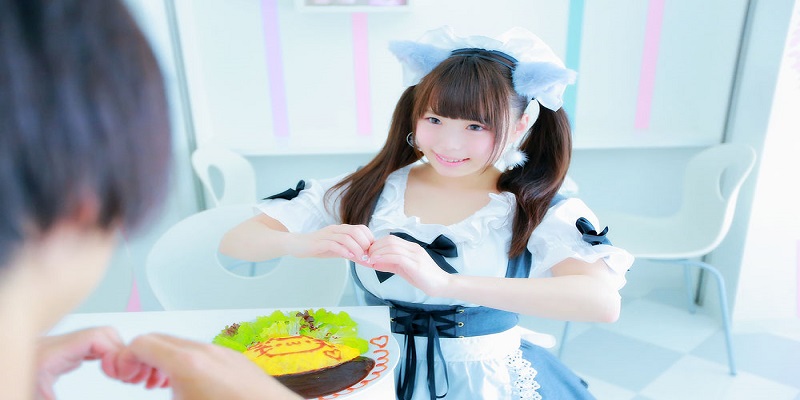






![11 Maid Cafe Ranking in Tokyo [Recommended even to beginners and ladies!]](https://jatrabridge.com/wp-content/uploads/slider/cache/11597c33ae53b47eb36a2f67968e635f/Maid-Cafe-Ranking-in-Tokyo2.3.jpg)

















